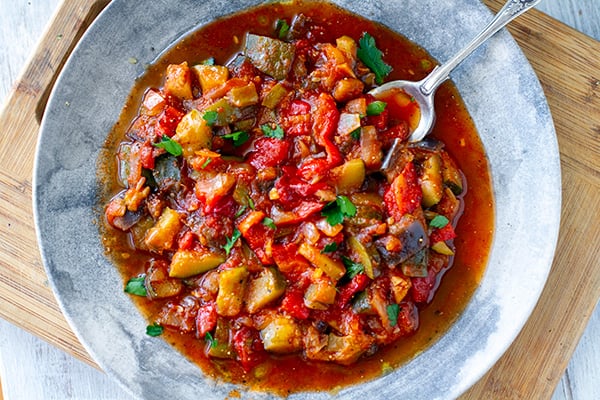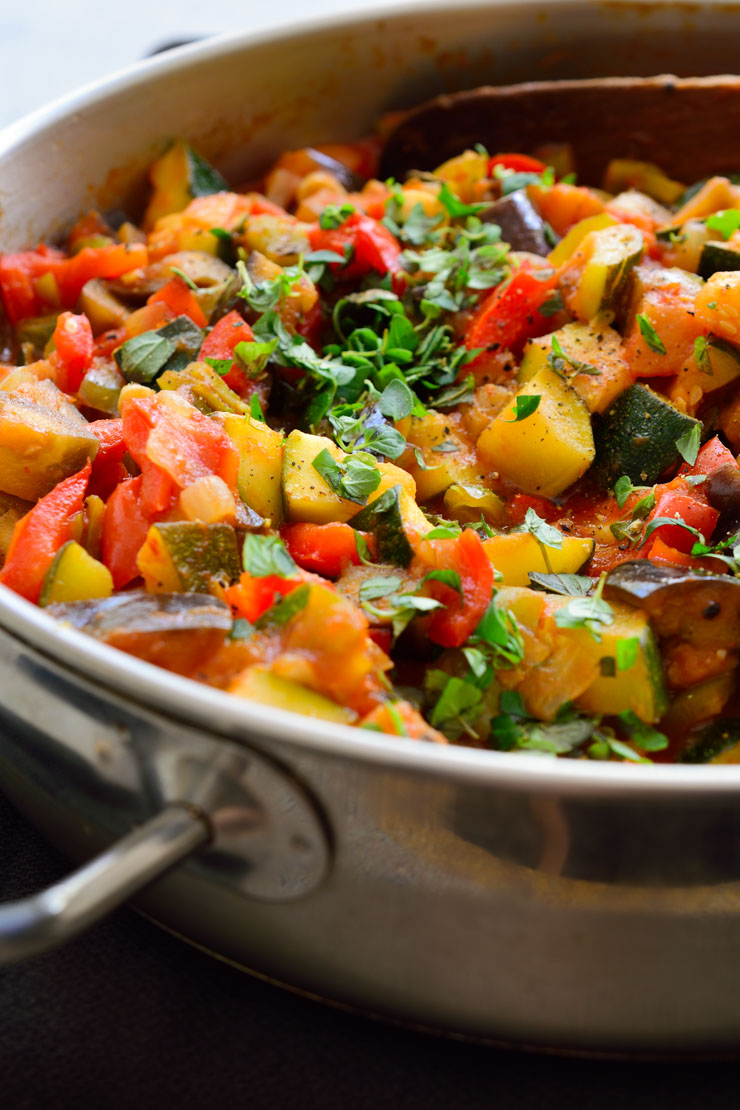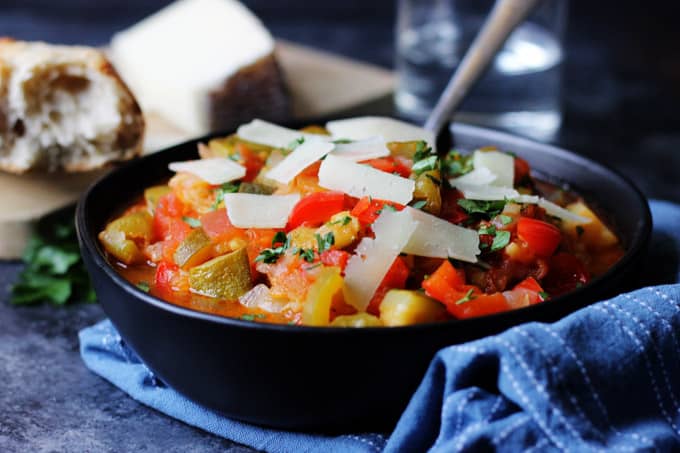On a journey that spanned the bustling markets and serene countryside of Spain, I discovered a dish that perfectly encapsulates the essence of Spanish peasant cuisine: Pisto, a vibrant Spanish Vegetable Stew. This hearty stew, a medley of summer vegetables including bell peppers, eggplants, and zucchinis, simmers slowly to meld into a symphony of flavors that speak of the rich farmlands from which they came. Each vegetable contributes its unique texture and taste, from the soft, creamy eggplant to the sweet, roasted bell peppers and the tender zucchini. Captivated by the simplicity and depth of flavors in Pisto, I was inspired to recreate this traditional dish at home. Through a process of trial and adjustment, embracing the seasonal produce and the slow, loving preparation that it demanded, I crafted a version of Pisto that brought the sun-kissed Spanish landscapes into my kitchen. Now, it is with great pleasure and a wish to share the warmth of Spanish hospitality that I present to you my rendition of Pisto, hoping to transport you to the heart of Spain with every bite.

Pisto (Spanish Vegetable Stew)
Equipment
- 1 roasting pan
Ingredients
- 1 teaspoon honey
- 2 medium zucchini
- 1.5 cans tomatoes
- 1.5 teaspoons salt
- 1 green bell pepper
- 2 garlic cloves
- 1 large eggplant
- 1/2 long red chili
- 1 red bell pepper
- Good quality olive oil
- 1 large onion
- 1/2 teaspoon salt
Instructions
- Spray the eggplant with salts and slice it into pieces.
- Allow for 15-20 minutes of rest time.
- In a big, roasting pan, heat four tablespoons of canola oil over moderate flame.
- Combine the onions, chili, and diced beans in a large mixing bowl. Cook for 12-14 minutes over moderate flame.
- Fry for 4-5 minutes, mixing halfway through, until the eggplant is golden brown.
- Remove the eggplant from the pan and drizzle with a little more canola oil.
- Cook for another 4-5 minutes after adding the zucchini.
- Ultimately, mix in the pre-fried zucchini and eggplant to the tomatoes concentrate in the pot.
- Cover and cook for 25 minutes over a moderate flame with a seal.
Cooking Tips about Pisto (Spanish Vegetable Stew)

- Quality of Vegetables: The essence of a great Pisto lies in the freshness and quality of its vegetables. Choose ripe bell peppers, firm eggplants, and tender zucchinis. The vibrancy of the vegetables not only contributes to the dish’s vivid color palette but also to its depth of flavor.
- Sautéing Vegetables Separately: Each vegetable in Pisto has its own unique texture and cooking time. Sautéing them separately before combining them into the stew allows each one to maintain its integrity and contribute its distinct flavor to the dish fully.
- Olive Oil is Key: Do not skimp on the quality of olive oil. A good Spanish olive oil will lend Pisto a rich, fruity base that is unmistakable in Mediterranean cooking. Use it generously in the initial sautéing of the vegetables and as a finishing touch before serving.
- Layering Flavors: Begin with onions and garlic, adding them to the olive oil until they are translucent and fragrant. This foundational flavor layer will act as a base upon which the other vegetables build.
- Tomatoes as a Thickener: Use ripe tomatoes or high-quality canned tomatoes to give the stew its characteristic thick consistency and acidity. Cooking down the tomatoes until they break apart and meld with the other vegetables is crucial for achieving the perfect balance of flavors.
- Slow and Low Cooking: Pisto benefits from a slow cooking process, allowing the flavors to meld together harmoniously. After combining all the ingredients, let the stew simmer on low heat, stirring occasionally to prevent sticking while ensuring the vegetables reach a tender, but not mushy, consistency.
- Seasoning: Keep the seasoning simple to allow the natural flavors of the vegetables to shine. A touch of salt, pepper, and perhaps a sprinkling of Spanish paprika for a slight smoky note are all you need. Fresh herbs like parsley can be added at the end for a burst of color and freshness.
- Serving Suggestions: Traditionally, Pisto can be served hot or at room temperature, making it versatile. It’s delightful on its own, topped with a fried egg, or as a side dish to meats and fish. For a rustic and hearty meal, serve it with crusty bread to dip into the stew.
- Rest Before Serving: Allowing the Pisto to rest off-heat for a few minutes before serving can enhance its flavors, as the vegetables absorb the aromatic juices and olive oil, creating a richer taste experience.
Serving suggestions about Pisto (Spanish Vegetable Stew)

- Traditional Presentation: Pisto is best served in a rustic, earthenware dish or a deep ceramic bowl that showcases its colorful components. The earthy tones of the serving dish will complement the stew’s vibrant appearance, enhancing its visual appeal.
- Garnishing for Flavor and Color: Before serving, garnish the Pisto with freshly chopped herbs—basil or parsley work wonderfully—to add a burst of color and freshness. A drizzle of high-quality extra virgin olive oil can also add depth and a silky finish.
- Accompaniments: To turn the Pisto into a more filling meal, consider serving it with a side of Spanish rice or crusty bread. These sides are perfect for soaking up the delicious juices, ensuring not a single drop goes to waste.
- Adding Protein: While Pisto is a vegetarian dish, it can be served with a fried egg on top or slices of grilled chorizo on the side for those who prefer an added protein element. Both options complement the flavors of the stew and cater to a broader range of dietary preferences.
- Temperature Consideration: Pisto can be enjoyed both hot or at room temperature. Serving it slightly cooled is a great way to appreciate the full spectrum of its flavors, especially during warmer months.
- Pairing with Wine: A glass of light to medium-bodied Spanish red wine, such as a Tempranillo, or a crisp white wine like Verdejo, can beautifully complement the dish’s complex flavors, making the meal even more enjoyable.
- Creating the Ambiance: Enhance the dining experience by evoking the feel of a Spanish eatery. Simple, warm décor, some Spanish guitar music in the background, and perhaps dimmed lighting can make the meal feel special and transport your guests straight to Spain.
Top 5 FAQs about Pisto (Spanish Vegetable Stew)

- What is Pisto? Pisto is a traditional Spanish vegetable stew that celebrates the bounty of the summer garden. It’s a medley of vegetables such as bell peppers, zucchinis, eggplants, tomatoes, and onions, all simmered together to create a dish that’s rich in flavors and textures. It’s often considered Spain’s answer to ratatouille and is revered for its simplicity and the way it highlights seasonal produce.
- Can I use canned tomatoes for Pisto? Yes, while fresh tomatoes are preferred when they’re in season, using high-quality canned tomatoes is a suitable alternative, especially during the off-season. Canned tomatoes can provide the stew with a consistently rich tomato base and are convenient to use. If possible, choose whole peeled tomatoes as they tend to be of higher quality than diced or crushed tomatoes.
- Is Pisto meant to be served as a main dish or a side dish? Pisto is incredibly versatile in that it can be served both as a main dish or a side. Traditionally, it may be served hot or cold, on its own with crusty bread, or topped with a fried egg. As a side dish, it pairs beautifully with grilled meats or fish. The serving method can vary based on personal preference or the occasion.
- How can I prevent my vegetables from becoming too mushy in Pisto? The key to preventing mushy vegetables is to sauté them separately based on their cooking times before combining everything into the final stew. This ensures that each vegetable maintains its integrity and contributing its full flavor to the dish. Additionally, simmering the combined stew gently and avoiding overcooking will help maintain the desirable textures of the individual vegetables.
- What makes Pisto different from other vegetable stews like ratatouille or caponata? While Pisto shares similarities with other Mediterranean vegetable stews like ratatouille and caponata, it is distinguished by its preparation and seasoning. Pisto typically places a greater emphasis on sautéing the vegetables separately before combining them, preserving their distinct textures and flavors. Furthermore, the seasoning in Pisto tends to be simpler, relying primarily on the natural flavors of the vegetables, good quality olive oil, and sometimes a touch of smoked paprika, distinguishing it from the more herb-heavy ratatouille or the sweeter, vinegar-accented caponata.
In essence, Pisto is not merely a stew but a testament to the power of cooking to bring people together, to transcend language and cultural barriers, and to turn every meal into an opportunity for connection and celebration. As you scoop the tender vegetables onto your plate, topped perhaps with a perfectly fried egg or a slice of crusty bread on the side, remember that each bite carries with it centuries of tradition, a symphony of flavors, and the simple yet profound pleasure of Spanish home cooking.

Leave a Reply